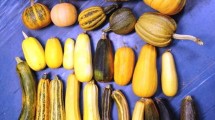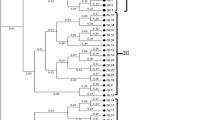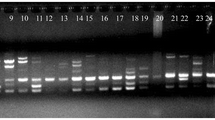Abstract
Random nuclear restriction fragment length polymorphisms (RFLPs) were used to assess similarities and relationships among open-pollinated (OP) populations of the cultivated bulb onion (Allium cepa). Seventeen OP populations and 2 inbreds of contrasting daylength response [termed by convention as long (LD) and short (SD) day], 1 shallot (A. cepa var. ascalonicum), and one cultivar of bunching onion (Allium fistulosum) were examined with 104 cDNA clones and two to four restriction enzymes. Sixty (58%) clones detected at least 1 polymorphic fragment scorable among the OP populations and were used for analyses. The average number of polymorphic fragments per polymorphic probe-enzyme combination was 1.9, reflecting that numerous monomorphic fragments were usually present. Similarities were estimated as the proportion of polymorphic fragments shared by 2 populations. Average similarity values among LD, among SD, and between LD and SD OP populations were 0.79, 0.67, and 0.68, respectively. Relationships among the OP populations were estimated by parsimony, cluster analysis of similarities using the unweighted-pair-group method (UPGMA), and multivariate analysis using principle components. Parsimony analysis generated a strict consensus tree that grouped all but 1 LD onion with unresolved relationships to the SD OP populations. The UPGMA analysis placed together the LD storage OP populations. Principal component analysis grouped all but 2 LD onions; the other OP populations were dispersed. The results suggest that LD and SD onions do not represent distinct germ plasm, but that LD storage onions represent a derived group selected for production at higher latitudes. If it is assumed that the sampled populations are representative of all onion OP populations, the lower similarities among SD OP populations indicate that their collection and maintenance in germ plasm collections is important for the preservation of genetic diversity.
Similar content being viewed by others
References
Allen E (1931) A progress report on onion investigations in the Arkansas Valley. Colo Agric Exp Stn Press Bull 75
Anonymous (1935) Spanish onion breeding. Annu Rep Colo Exp Stn 48:24–25
Bennett M, Smith J (1976) Nuclear DNA amounts in angiosperms. Philos Trans R Soc London Ser B 274:227–274
Brummer E, Kochert G, Bouton J (1991) RFLP variation in diploid and tetraploid alfalfa. Theor Appl Genet 83:89–96
Corgan M (1988) ‘NuMex Sunlite’ onion. Hortscience 23:423–424
Currah L, Proctor F (1990) Onions in tropical regions. Nat Res Inst Bull 25, Kent, UK
Debener T, Salamini F, Gebhardt C (1990) Phytogeny of wild and cultivated Solanum species based on nuclear restriction fragment length polymorphisms (RFLPs). Theor Appl Genet 79:360–368
Dorfman D, Zon L, Orkin S (1989) Rapid amplification of λgt11 bacteriophage library inserts from plaques using the polymerase chain reaction. Biotechniques 7:568–570
Dowker B (1990) Onion breeding. In: Rabinowitch H, Brewster J (eds) Onions and allied crops, vol 1. CRC Press, Boca Raton, Fla., pp 215–232
Ehiobu N, Goddard M (1990) Heterosis in crosses between geographically separated populations of Drosophila melanogaster. Theor Appl Genet 80:569–575
El-Shafie M, Davis G (1967) Inheritance of bulb color in the onion (Allium cepa L.) Hilgardia 9:607–622
Feinberg A, Vogelstein B (1983) A technique for radiolabeling DNA restriction endonuclease fragments to high specific activity. Anal Biochem 132:6–13
Figdore S, Kennard W, Song K, Slocum M, Osborn T (1988) Assessment of the degree of restriction fragment length polymorphism in Brassica. Theor Appl Genet 75:833–840
Gerdes J, Tracy W (1994) Diversity of historically important sweet corn inbreds as estimated by RFLPs, morphology, isozymes and pedigree. Crop Sci 34:26–33
Hallauer A, Miranda J (1988) Quantitative genetics in maize breeding, 2nd edn. Iowa State University Press, Ames, Iowa
Hanelt P (1990) Taxonomy, evolution, and history. In: Rabinowitch H, Brewster J (eds) Onions and allied crops, vol 1. CRC Press, Boca Raton. Fla., pp. 1–26
Havey M (1992) Restriction enzyme analysis of the chloroplast and nuclear 45s ribosomal DNA of Allium sections Cepa and Phyllodolon. Plant Syst Evol 183: 17–31
Havey M (1993) A putative donor of S-cytoplasm and its distribution among open-pollinated populations of onion. Theor Appl Genet 86:128–134
Havey M, Bark O (1994) Molecular confirmation that sterile cytoplasm has been introduced into open-pollinated cultivars of Grano onions. J Am Soc Hortic Sci 119:90–93
Havey M, Muehlbauer F (1989a) Linkage between restriction fragment length, isozyme, and morphological markers in lentil. Theor Appl Genet 77:395–401
Havey M, Muehlbauer F (1989b) Variability for restriction fragment lengths and phlogenies in lentil. Theor Appl Genet 77:839–843
Helentjaris T, King G, Slocum M, Siedinstrang C, Wegman S (1985) Restriction fragment length polymorphisms as probes for plant diversity and their development as tools for applied plant breeding. Plant Mol Biol 5:109–118
Hosfield G, Vest G, Peterson C (1977) Heterosis and combining ability in a diallel cross of onions. J Am Soc Hortic Sci 102:355–360
Jones H, Davis G (1944) Inbreeding and heterosis and their relation to the development of new varieties of onions. US Dept Agric Tech Bull 874
Jones H, Mann L (1963) Onions and their allies. Interscience Publ, New York
Joshi H, Tandon J (1976) Heterosis for yield and its genetic basis in onion. Indian J Agric Sci 46:88–92
Kalkman E (1984) Analysis of the C-banded karyotype of Allium cepa L.: standard system of nomenclature and polymorphism, Genetica 65:141–148
Lefort-Buson M, Guillot-Lemoine B, Dattee Y (1987) Heterosis and genetic distance in rapeseed (Brassica napus L.): crosses between European and Asiatic selfed lines. Genome 29:413–418
Liu Y, Nori N, Tsunewaki K (1990) Restriction fragment length polymorphism (RFLP) analysis in wheat. I. Genomic DNA library construction and RFLP analysis in common wheat. Jpn J Genet 65:367–380
Lynch M (1991) Analysis of population genetic structure by DNA fingerprinting. In: Burke T, Dolf G, Jeffrey A, Wolff R (eds) DNA fingerprinting approaches and applications. Birkhauser Verlag, Basel, Switzerland, pp 113–126
Maggini F, Barsanti P, Marazia T (1978) Individual variation of the nucelolus organizer regions in Allium cepa and Allium sativum. Chromosoma 66:173–184
Magruder R, Allard H (1937) Bulb formation in some American and European varieties of onion as affected by length of day. J Agric Res 54:719–752
Magruder R, Webster R, Jones A, Randall T, Snyder G, Brown H, Hawthorn L, Wilson A (1941) Descriptions of types of principal American varieties of onions. USDA Misc Pub No 435, Washington, D.C.
McCollum G (1966) Heritability and genetic correlation of some onion bulb traits. J Hered 57:57:105–110
McCollum G (1968) Heritability and genetic correlation of soluble solids, bulb size and shape in white sweet Spanish onion. Can J Genet Cytol 10:508–514
McCollum G (1971) Heritability of onion bulb shape size. J Hered 62:101–104
McCollum G (1976) Onions and allies. In: Simmonds F (ed) Evolution of crop plants. Longman, London New York, pp 186–190
McCouch S, Kochert G, Yu Z, Khush G, Coffman W, Tanksley S (1988) Molecular mapping of rice chromosomes. Theor Appl Genet 76:815–829
Melchinger A, Messmer M, Lee M, Woodman W, Lamkey K (1991) Diversity and relationships among U.S. maize inbreds revealed by restriction fragment length polymorphisms. Crop Sci 31:669–678
Murray M, Thompson W (1980) Rapid isolation of high-molecularweight plant DNA. Nucleic Acids Res 8:4231–4325
Nagai S (1983) Onion cultivars. In: Komochi S (ed) Cultivation techniques of spring-sown onions. Association for the Extension of Agrictural Techniques, Japan, pp 17–38
Nei M, Li W (1979) Mathematical model for studying genetic variation in terms of restriction endonucleases. Proc Natl Acad Sci USA 76:5269–5273
Peffley E, Castillo O (1987) Polymorphism of isozymes within plant introductions of Allium cepa L. and A. fistulosum L. HortScience 22:956–957
Rohlf F (1992) NTSYS-pc: numerical taxonomy and multivariate analysis system. Exeter Software, Setauket, N.Y.
Sambrook J, Fritsch E, Manistis T (1989) Molecular cloning: a laboratory manual. Cold Spring Harbor Press, Cold Spring Harbor, N.Y.
Sanderson M, Donoghue M (1989) Patterns of variation in levels of homoplasy. Evolution 43:1781–1795
Sato S (1981) Cytological studies on the satellited chromosomes of Allium cepa. Caryologia 34:431–440
Smith J, Smith O (1989) The description and assessment of distances between inbred lines of maize: II. the utility of morphological, biochemical and genetic descriptors and a scheme for the testing of distinctiveness between inbred lines. Maydica 34:141–150
Smith O, Smith J, Bowen S, Tenborg R, Will S (1990) Similarities among a group of elite maize inbreds as measured by pedigree, F1 grain yield, grain yield heterosis and RFLPs. Theor Appl Genet 80:833–840
Song K, Osborn T, Williams P (1988) Brassica taxonomy based on nuclear restriction fragment length polymorphism (RFLPs). II. Preliminary analysis of subspecies within B. rapa (sys. campestris) and B. oleracea. Theor Appl Genet 76:593–600
Southern E (1975) Detection of specific sequences among DNA fragments separated by gel electrophoresis. J Mol Biol 98:503–507
Author information
Authors and Affiliations
Additional information
Communicated by J.S. Beckmann
Rights and permissions
About this article
Cite this article
Bark, O.H., Havey, M.J. Similarities and relationships among populations of the bulb onion as estimated by nuclear RFLPs. Theoret. Appl. Genetics 90, 407–414 (1995). https://doi.org/10.1007/BF00221983
Received:
Accepted:
Issue Date:
DOI: https://doi.org/10.1007/BF00221983




